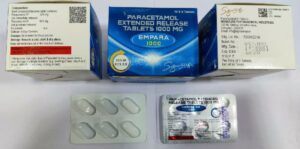650 customer reviews) | 1280 Viewed
Active Ingredient (Generic Name): PARACETAMOL 325MG (IR), PARACETAMOL 675MG (SR)
Indication:
Manufacturer: Signature
Packaging: 10 Pills in 1 strip
Delivery Time: 6 To 21 days
Categories:


| Quantity | Price | Price/Unit | Add To Cart |
|---|---|---|---|
| 30 pills | $15 | $ 0.5 | $15.00Buy Now |
| 60 pills | $24 | $ 0.4 | $24.00Buy Now |
| 90 pills | $33 | $ 0.37 | $33.00Buy Now |
| 180 pills | $63 | $ 0.35 | $63.00Buy Now |
| 250pills | $81 | $ 0.32 | $81.00Buy Now |
| 500pills | $137 | $ 0.27 | $137.00Buy Now |
EMPARA 1000 is a medication that contains empagliflozin as its active ingredient. It is primarily used to treat type 2 diabetes by lowering blood sugar levels. EMPARA 1000 works by blocking the reabsorption of glucose in the kidneys, which results in the elimination of excess glucose from the body through urine.
EMPARA 1000 is used to treat type 2 diabetes. It is usually prescribed along with diet and exercise to help control blood sugar levels. It can also be used in combination with other diabetes medications such as insulin or metformin. EMPARA 1000 can also help reduce the risk of cardiovascular events such as heart attacks, stroke, or death in patients with type 2 diabetes who have established cardiovascular disease.
The recommended dosage of EMPARA 1000 is one tablet once daily, with or without food. It should be taken at the same time each day. The tablet should be swallowed whole and not crushed, split, or chewed.
The most common side effects of EMPARA 1000 include genital yeast infections, urinary tract infections, and increased urination. Other possible side effects include dehydration, low blood pressure, dizziness, nausea, and diarrhea. In rare cases, EMPARA 1000 can cause serious side effects such as ketoacidosis, bone fractures, and hypersensitivity reactions.
Before taking EMPARA 1000, patients should inform their healthcare provider of any allergies or medical conditions they have. Patients should also inform their doctor of any medications they are currently taking, including over-the-counter drugs and herbal supplements. EMPARA 1000 should not be used by patients with type 1 diabetes, diabetic ketoacidosis, severe renal impairment, or end-stage renal disease. It should also be used with caution in patients with a history of genital yeast infections.
EMPARA 1000 is a medication used to treat type 2 diabetes by lowering blood sugar levels. It works by blocking the reabsorption of glucose in the kidneys, resulting in the elimination of excess glucose through urine. EMPARA 1000 is generally well-tolerated, but patients should be aware of the possible side effects and precautions to take when using this medication.
Q: Can EMPARA 1000 be used to treat type 1 diabetes?
A: No, EMPARA 1000 is not indicated for the treatment of type 1 diabetes.
Q: Can EMPARA 1000 be taken with other diabetes medications?
A: Yes, EMPARA 1000 can be taken in combination with other diabetes medications such as insulin or metformin.
Q: How should EMPARA 1000 be taken?
A: The recommended dosage of EMPARA 1000 is one tablet once daily, with or without food. It should be taken at the same time each day and swallowed whole.
Q: What are the possible side effects of EMPARA 1000?
A: The most common side effects of EMPARA 1000 include genital yeast infections, urinary tract infections, and increased urination. Other possible side effects include dehydration, low blood pressure, dizziness, nausea, and diarrhea. In rare cases, EMPARA 1000 can cause serious side effects such as ketoacidosis, bone fractures, and hypersensitivity reactions.
Q: How long does it take for EMPARA 1000 to start working?
A: EMPARA 1000 can start working within the first week of treatment. However, it may take up to 2-4 weeks to see the full effect on blood sugar levels.
Q: Can EMPARA 1000 be used during pregnancy or breastfeeding?
A: EMPARA 1000 is not recommended for use during pregnancy or breastfeeding due to the lack of data on its safety in these populations.
Q: Can EMPARA 1000 cause hypoglycemia (low blood sugar)?
A: EMPARA 1000 is not known to cause hypoglycemia when used alone. However, when used in combination with other diabetes medications that can cause hypoglycemia, the risk of hypoglycemia may be increased.
Q: Does EMPARA 1000 have any effect on body weight?
A: EMPARA 1000 may lead to a modest reduction in body weight due to its mechanism of action in the kidneys. However, weight loss is not the primary goal of treatment with EMPARA 1000.
Q: How often do I need to have my kidney function checked while taking EMPARA 1000?
A: Kidney function should be assessed before starting EMPARA 1000 and then periodically thereafter. The frequency of kidney function tests may vary depending on the patient’s individual needs and risk factors for kidney disease.
Q: Can EMPARA 1000 be used in patients with liver disease?
A: EMPARA 1000 should be used with caution in patients with liver disease as it has not been studied extensively in this population. Patients with severe liver disease should not take EMPARA 1000.
Overall, EMPARA 1000 can be an effective treatment option for patients with type 2 diabetes. However, as with any medication, it is important to be aware of its possible side effects and precautions to take while using it. Patients should discuss the benefits and risks of EMPARA 1000 with their healthcare provider to determine if it is the right treatment option for them.
EMPARA 1000 is a medication used for the treatment of type 2 diabetes. It contains the active ingredient empagliflozin, which belongs to a class of medications called sodium-glucose co-transporter 2 (SGLT2) inhibitors. SGLT2 inhibitors work by blocking the reabsorption of glucose in the kidneys, which increases the amount of glucose excreted in the urine, thereby lowering blood sugar levels.
EMPARA 1000 is usually taken once daily in the morning with or without food. The recommended starting dose is 10 mg, which can be increased to 25 mg if needed. Patients with kidney impairment may require a lower dose or a different dosing schedule.
The most common side effects of EMPARA 1000 include genital yeast infections, urinary tract infections, and increased urination. In rare cases, EMPARA 1000 may cause serious side effects such as ketoacidosis, which is a potentially life-threatening condition where the body produces high levels of ketones, and severe urinary tract infections.
Patients using EMPARA 1000 should take precautions to reduce their risk of developing genital yeast infections or urinary tract infections. This includes practicing good hygiene, keeping the genital area dry, and drinking plenty of fluids. Patients should also inform their healthcare provider if they experience symptoms such as fever, chills, or back pain, which may indicate a urinary tract infection.
Patients with a history of ketoacidosis or those who are prone to developing this condition should not use EMPARA 1000. Additionally, EMPARA 1000 should not be used in patients with type 1 diabetes or diabetic ketoacidosis.
In conclusion, EMPARA 1000 is a medication used for the treatment of type 2 diabetes that can be effective in lowering blood sugar levels. However, it is important to be aware of its possible side effects and precautions to take while using it. Patients should discuss the benefits and risks of EMPARA 1000 with their healthcare provider to determine if it is the right treatment option for them.